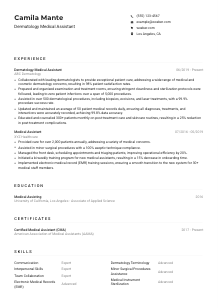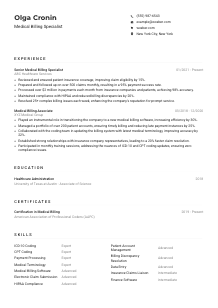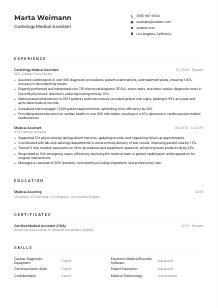Health Information Technician Resume Example
Jotting down medical details, but your resume seems unresponsive? Check out this Health Information Technician resume example, finesse-crafted with Wozber free resume builder. See how to structure your medical record-keeping skills to sync with job specifications, and set your career prognosis at its healthiest pace!

How to write a Health Information Technician resume?
Congratulations on taking the proactive step towards landing your dream role as a Health Information Technician! In the intricate weave of today's job market, standing out is not just a goal—it's a necessity. Your resume is your personal sales pitch, the crystallized essence of your professional life, ready to impress and convince.
With Wozber's free resume builder, you're equipped to craft a resume tailored perfectly to the nuances of a Health Information Technician position, ensuring it's a mirror reflection of the role you aspire to fill. Let's dive into the heart of making your resume not just good, but great—ensuring it speaks directly to hiring managers and sails through Applicant Tracking Systems (ATS) with ease.
Personal Details
First impressions count, and in the realm of resumes, the Personal Details section is your frontliner. This segment, though seemingly straightforward, carries the weight of first glances and initial judgments. As a budding Health Information Technician, let's meticulously craft this section to make sure it resonates with your professional persona and aligns seamlessly with the job's geography and expectations.
1. Identify
Begin with the basics: your name. It's your headline, your brand. Make it prominent, make it memorable. Adopt a font that's clean and professional—let it stand out, yet remain integrated into the overall aesthetic.
2. Role Reflection
Echo the role you're aspiring for right below your name, adding "Health Information Technician". It's not just about stating who you are; it's about aligning your identity with the job at hand, signaling to the ATS and the hiring manager that you're a direct match.
3. Contact Clarity
Include your phone number and a professional email address—like firstname.lastname@email.com. Precision here ensures you're reachable; a typo could mean a missed opportunity. If relocation is not an issue (or if you're already situated in San Francisco, California, as the job demands), highlighting your current location can be a deal-maker.
4. Professional Presence
In today's digitalized world, a LinkedIn profile or a personal website showcasing your portfolio can significantly strengthen your application. Ensure they're polished and reflective of your professional narrative, providing a deeper dive into your accomplishments and skills.
5. Privacy Protocol
Avoid personal details unrelated to your job application. Your resume should focus on professional qualifications and achievements. Privacy matters, and so does a clutter-free presentation of your professional identity.
Takeaway
The Personal Details section is your launch pad. It should be crisp, clear, and reflective of your professional journey and the specific position you're applying for. Think of it as laying down the welcome mat for the reader, inviting them to explore the detailed landscape of your professional prowess.





Experience
The core of any resume, the experience section, is where you demonstrate your journey, spotlighting the relevance and impact of your past roles. For a Health Information Technician, this involves a blend of technical aptitude and collaborative accomplishments. Your role is pivotal in managing patient data with precision—a responsibility that requires both detail-oriented focus and seamless teamwork.
- Organized and managed health information data, leading to a 99% accuracy rate in patient records.
- Reviewed over 500 patient charts monthly, ensuring 100% compliance with regulations.
- Compiled and maintained over 10,000 patient profiles, documenting intricate medical histories and treatment details.
- Collaborated with a team of 50 medical staff members, ensuring up‑to‑date and readily available patient information for timely treatment decisions.
- Generated and presented 20 monthly statistical reports, which were utilized to enhance patient care and data needs.
- Digitized 5,000+ paper‑based medical records into electronic health record (EHR) software, resulting in a 40% improvement in data retrieval speed.
- Established a more efficient data entry process, reducing entry errors by 30%.
- Provided training to 20+ staff members on EHR software utilization, enhancing the clinic's digital transformation process.
- Played a pivotal role in ensuring HIPAA compliance within the medical records department.
- Spearheaded the process of migrating data from an outdated HIM system to a modern database, resulting in a 20% increase in data accessibility.
1. Analyze the Job Description
Take a magnifying glass to the job description, paying special attention to phrases like 'manage health information data' or 'collaborate with medical staff'. These are not just responsibilities—they're keywords. Integrating them smoothly into your experience section ensures you're speaking the same language as the ATS and the hiring team.
2. Highlight Relevant Positions
Structure your history strategically, placing emphasis on roles and projects that spotlight your expertise in EHR software, medical coding, and compliance with health information regulations. Your role at a previous healthcare institution where you led a project to improve data retrieval speeds is not just an achievement; it's proof of your capability and impact.
3. Results-Driven Description
Frame your contributions in terms of tangible outcomes. Did you enhance data accuracy? Improve compliance rates? These accomplishments, especially when quantified, tell a compelling story of your effectiveness and dedication.
4. Quantify Success
Numbers speak volumes. By saying you 'Reviewed over 500 patient charts monthly, ensuring 100% compliance with regulations', you offer concrete evidence of your diligence and skill. It's these specifics that transform a good resume into a great one.
5. Relevance is Key
Align every bullet point to the heart of what makes a successful Health Information Technician. Irrelevant achievements, however impressive, can dilute the potency of your application. Stay focused, stay relevant, and every line will be a step closer to that job offer.
Takeaway
Your experience section is your storybook. Each role you've embraced should unfold in a way that mesmerizes and convinces. Weave your professional journey with clarity and purpose, ensuring each word and each achievement pivots you closer to your new role. Let your experience sing in harmony with the needs and aspirations of your future employer.
Education
The foundation of your career, the education section, albeit brief, serves as a bedrock to your qualifications. As a Health Information Technician, it's not just about listing degrees; it's about showcasing a background that's rich, relevant, and reflective of the job's prerequisites. Tailoring this section to echo the depth of your academic journey can set you apart.
1. Highlight Your Degree
Make sure your degree ties directly into the role. For instance, an 'Associate degree in Health Information Technology' from an esteemed institution like the University of California, Los Angeles, not only meets the job's educational requirement but also underscores your preparedness for the role.
2. Present with Precision
Structure this section for quick readability—degree, field, institution, and graduation year. This clarity ensures the hiring manager can swiftly assess your qualifications without needing to sift through paragraphs.
3. Match Job Specifications
If the job specifically mentions a degree in Health Information Technology or a related field, listing your matching degree front and center validates your candidacy from the get-go. This direct match is a nod to the ATS, too, helping ensure your resume gets in the right hands.
4. Relevant Courses or Achievements
Though your degree speaks volumes, don't overlook the power of relevant coursework, projects, or achievements. If you led a noteworthy project or excelled in a course directly relevant to health information management, these details can add depth to your academic profile.
5. Beyond the Classroom
Should your academic journey include honors, extracurriculars, or clubs that shine a light on your leadership, dedication, or teamwork skills—especially in contexts relevant to health information technology—highlight these. They provide a holistic view of your capabilities and character.
Takeaway
Your education section is the foundation upon which your professional qualifications stand. It's a testament to your preparation, commitment, and relevance to the role at hand. Craft it with care, ensuring it echoes not just the requirements of the job but the depth and breadth of your academic journey. Let it underscore your readied stance for the intricate responsibilities of a Health Information Technician.
Certificates
In the ever-evolving field of health information, certifications are more than accolades; they're affirmations of your dedication, expertise, and ongoing commitment to excellence. For a Health Information Technician, specific certifications like CCA or RHIT are not merely impressive—they're essential. Let's tailor your certificates section to illuminate these badges of honor in a way that aligns flawlessly with the job's expectations.
1. Review Job Prerequisites
Revisit the job posting with a keen eye, noting certifications explicitly requested. For our role, being a 'Certified Coding Associate (CCA)' or a 'Registered Health Information Technician (RHIT)' stands out not just as a credential but as a prerequisite. These certifications should headline your certificates section.
2. Prioritize Pertinence
In a landscape of many achievements, prioritize those directly relevant to your targeted role. Showcase your 'CCA' or 'RHIT' certification prominently. This direct correlation between your qualifications and the job's requirements speaks volumes to the hiring manager and the ATS alike.
3. Date Details Matter
Certifications often come with an expiration date, signaling their current relevance. Highlight the acquisition or renewal dates of your certifications, such as '2019 - Present' for both CCA and RHIT. This timeframe not only showcases your up-to-date expertise but also evidences your proactive stance in maintaining it.
4. Commit to Continual Learning
The world of health information is perpetually in flux, with new standards, regulations, and technologies emerging. Your commitment to continuing education through certifications signals your readiness to evolve and adapt. Listing recent or ongoing certification efforts can thus be a powerful testament to your growth mindset.
5. Embrace the Narrative
Your certifications tell a story—not just of past achievements, but of your journey towards excellence and your vision for the future. Integrating them into your resume with foresight and strategy ensures they contribute to the narrative arc of your professional identity.
Takeaway
Your certifications are more than credentials; they're the milestones that mark your professional journey. By aligning them closely with the requirements of your desired Health Information Technician role, you not only comply with the prerequisites but also signal your dedication to excellence, your expertise, and your ongoing commitment to your profession. Let these credentials shine, emphatically stating your readiness and qualification for the challenges ahead.
Skills
Your skills section is more than a list; it's a refined showcase of your professional arsenal, your ready-to-deploy competencies that make you the ideal candidate for a Health Information Technician. In a role that intertwines technical prowess with meticulous attention to detail and regulatory compliance, presenting a skills list that's both targeted and compelling is crucial.
1. Extract Key Skills
Dissect the job description to identify both stated and implied skills. For our Health Information Technician role, expertise in 'Electronic Health Record (EHR) software' and 'Medical Terminology' are explicitly valued, alongside softer skills like 'Communication' and 'Interpersonal Skills'. Cataloging these skills as part of your repertoire signals your alignment with the role's requirements.
2. Tailor Your Toolkit
Balance your skills list with a mix of technical and soft skills, directly mirroring those outlined in the job description. By listing skills such as 'Problem-solving', 'HIPAA Compliance', and 'Collaborative Work' alongside 'EHR Expertise', you paint a comprehensive picture of your capabilities, directly responding to the job's demands.
3. Emphasize Relevance
In a field as specialized as Health Information Management, relevance is key. Prioritize skills that directly impact the role you're applying for, and where possible, provide context that pinpoints how these skills have been applied in your professional journey. This contextualization transforms a simple list into a dynamic narrative of your professional toolkit.
Takeaway
The skills section of your resume is your professional emblem, a curated selection of competencies that marks you as the perfect fit for a Health Information Technician role. Focusing on relevance, balance, and alignment with the job description, you transform this section into a powerful testament to your readiness and suitability for the role. Let your skills shine, underscoring the unique value you bring to the table.
Languages
In a world ever more interconnected, linguistic skills can dramatically broaden the horizons of your professional capabilities. For a Health Information Technician, particularly in regions that benefit from multicultural fluency, showcasing your language skills can be a distinctive advantage.
1. Match Job Language Requirements
Start with the languages explicitly requested in the job listing. For instance, 'proficient English speaking skills' is a stipulation for our Health Information Technician role. Ensuring your resume highlights your proficiency in English is a straightforward nod to meeting the role's requirements.
2. Prioritize Relevance
If you're proficient in multiple languages, rank them based on the relevance to the job's location and the potential patient population you might interact with. In a city as diverse as San Francisco, additional languages like Spanish could significantly enhance your appeal to employers.
3. Be Transparent About Proficiency
Clarity about your language proficiency ensures realistic expectations. Using terms such as 'Native', 'Fluent', or 'Intermediate' provides hiring managers with a quick understanding of your communication strengths, making it easier to imagine how you'd fit into the team and patient interactions.
4. Contextualize Your Multilingual Skills
If applicable, provide context on how your multilingual skills have been a boon in past roles, especially in patient care or collaboration with diverse healthcare teams. This not only highlights your linguistic capabilities but also your ability to leverage them in professional scenarios.
5. Embrace the Global Perspective
Recognizing the increasing importance of bilingual or multilingual professionals in healthcare, your language skills can underscore your readiness for a healthcare environment that values diversity, empathy, and inclusivity.
Takeaway
Your proficiency in multiple languages isn't just a personal asset; it's a professional superpower. Aligning your language skills with the demands of a Health Information Technician role amplifies your appeal as a candidate who's not only skilled but also culturally adept and communicative. Let your resume reflect the linguistic breadth you bring to the table, accentuating the depth of interactions and connections you're capable of nurturing.
Summary
A gripping summary is your resume's opening act, an invitation to dive deeper into the narrative of your professional saga. For a Health Information Technician, it's an opportunity to distill the essence of your experience, skills, and aspirations into a few compelling lines—making it clear why you're the best fit for the role.
1. Synthesize the Role's Core
Your summary should echo the heart of the Health Information Technician role—managing, reviewing, and documenting health information data. Begin by weaving in the core skills and experiences that align with the job's demands, portraying yourself as a guardian of data integrity and a conduit of patient care.
2. Spark Interest with An Introduction
Craft an opening statement that captures your professional identity and passion for the field. For example, "Health Information Technician with over 5 years of in-depth experience" not only introduces your role but also your seasoned journey within it.
3. Thread in Relevant Highlights
Dive into your textured professional landscape, highlighting key accomplishments like enhancing data accuracy or fostering teamwork among medical staff. These specifics paint a vivid picture of your capabilities and your impact in previous roles.
4. Aim for Precision
Your summary should be a laser-focused beam of information, distilling your career's essence into a potent snapshot. It's about making every word count, ensuring each line resonates with the role you're aiming for and the value you bring to it.
Takeaway
Your summary is more than an introduction; it's your resume's thesis statement, encapsulating the compelling why and how of your candidacy. It sets the stage, inviting the reader on a journey through your professional narrative, one that's uniquely aligned with the role of a Health Information Technician. Craft it with care, let it beckon with the promise of your proficiency and passion, and watch as doors open to your next great opportunity.
Launching Your Health Information Technician Journey
Navigating the path to becoming a Health Information Technician is an adventure of precision, dedication, and continuous growth. Armed with a resume that speaks directly to the heart of what hiring managers seek, you're not just answering a job description—you're opening a dialogue about the unique value you bring. Remember, your resume is a living document, a reflection of your evolving journey. Fine-tune it, infuse it with your unique zeal, and let it be the keystone to the broadening horizons of your career.
The world of Health Information Technician is rich with challenges and triumphs, and it awaits your unique contributions. Step forward with confidence, armed with a resume that's as comprehensive, targeted, and dynamic as the career path you're embarking on. Your story is just beginning, and it promises to be a remarkable one!

- Associate degree in Health Information Technology or a related field.
- Certified Coding Associate (CCA) or Registered Health Information Technician (RHIT) certification.
- Minimum of 2 years' experience in medical coding, data abstraction, or Health Information Management (HIM) systems.
- Strong knowledge of electronic health record (EHR) software and medical terminology.
- Excellent communication and interpersonal skills.
- The role requires proficient English speaking skills.
- Must be located in San Francisco, California.
- Organize and manage health information data, ensuring its accuracy and accessibility.
- Review patient records for accuracy, completeness, and compliance with regulations.
- Compile and maintain patient profiles, documenting medical history and treatment details.
- Collaborate with medical staff, ensuring patient information is up to date and readily available for treatment decisions.
- Generate statistical reports, analyzing health data to better serve patient care and data needs.















